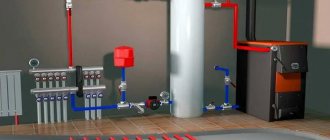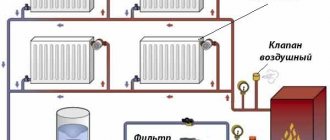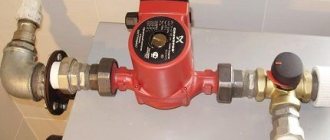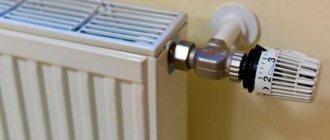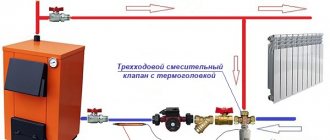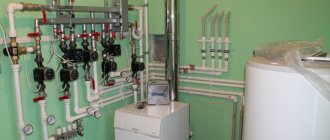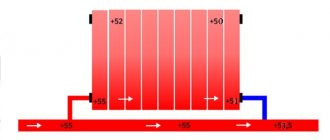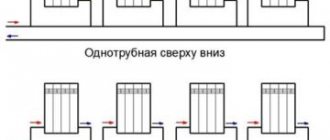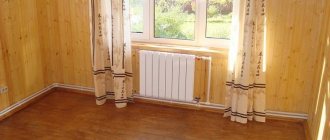All single-pipe systems with vertical risers require more materials for equipment, but are distinguished by their convenience and the ability to connect heating devices separately to each riser on all floors. In two-story buildings, it is quite simple to equip a water heating system without a pumping device with horizontal wiring.
To activate the circulation process, a special accelerating manifold can be installed on the second floor, after which several hot water circuits will be distributed throughout the second floor. The additional circuit should go down to the ground floor, where it will be divided into several main branches. In some cases, risers from radiators located at the very end of the circuit are additionally distributed to the first floor.
Methods for connecting the boiler to the heating circuit
The composition of the equipment and the boiler piping directly depends on the selected type of heating circuit, the method of circulation of the coolant and the degree of automation of the process, such as fine-tuning the climate or simply adjusting the heating of the coolant.
The task of the entire strapping complex is:
- Ensure uniform heat distribution throughout the heating circuit.
- Protect people and equipment from any emergency situations and minimize the consequences of a breakdown.
- Reducing the influence of frequency in the operation of a solid fuel boiler, since the main power is released only after the next load of fuel is ignited, while as it burns out, the heat transfer decreases.
How does a heating system without a pump work - options and device options
To make it possible to live in a built house outside the city regardless of the time of year, it needs high-quality heating. Among the wide variety of devices for heating a room, it is sometimes difficult to decide what exactly is needed in different life situations. One of the simplified options that can be equipped on your own is a heating system without a pump, in other words, with a real type of coolant circulation. In fact, we will talk about this type of heat supply further in the material.
How to install heating correctly
In order for a finished heating system with a natural circulation type to function correctly and efficiently, it is important to adhere to certain rules when installing it. In general, the installation diagram looks like this:
In general, the installation diagram looks like this:
- Heating radiators must be installed under the windows, preferably at the same level and maintaining the required indentations.
- Next, install the heat generator, that is, the selected boiler.
- Install the expansion tank.
- The pipes are laid out and the previously fixed elements are joined into a single system.
- The heating circuit is filled with water and a preliminary check for the tightness of the connections is performed.
- The final stage is to start the heating boiler. If everything works correctly, then the house will be warm.
Please pay attention to some nuances:
- The boiler should be located at the lowest point of the system.
- The pipes must be installed with a slope towards the return flow.
- There should be as few turns in the pipeline as possible.
- To increase heating efficiency, pipes with a larger diameter are required.
We hope this article will be useful to you, and you will be able to independently install a heating system without a circulation pump in your country house.
A heating system with natural circulation of liquid is a closed device of the gravitational (gravity) type, which allows you to heat rooms in a private house regardless of the power supply.
This advantage of the design makes it possible to use it in regions with problems or complete absence of a central electrical network. The system is economical, but for its proper functioning you will need to make accurate calculations.
In what cases can you do without a pump?
The movement of coolant inside the heating circuit occurs under the influence of the laws of physics. This means that when heated, the liquid rises, and as it cools, it falls again, thereby heating the room.
Most of all, a heating system without a circulation pump is in demand precisely in country houses and dachas, since in suburban conditions the power supply is not always stable or absent altogether. In this regard, heating equipment with a forced circulation type is impractical.
It is noteworthy that it is quite possible to install heating with natural coolant circulation yourself. In addition, such a system is very convenient to use.
Single-pipe heating circuit
From the heating boiler you need to draw a main line representing a branch. After this action, it contains the required number of radiators or batteries. The line, drawn according to the building designs, is connected to the boiler. The method creates coolant circulation inside the pipe, heating the building completely. The circulation of warm water is adjusted individually.
A closed heating scheme for Leningradka is planned. In this process, a single-pipe complex is installed according to the current design of private houses. At the owner's request, the following elements are added:
- Radiator controllers.
- Thermostats.
- Balancing valves.
- Ball valves.
Leningradka regulates the heating of certain radiators.
Heat supply with water as coolant
The operating specifics of water heating systems with this type of coolant circulation are determined by a number of parameters.
Considering what kind of expansion tank is used to equip a heating system with gravitational circulation of the coolant, they are distinguished:
- Open systems . In this case, the expansion tank is installed higher to create excess pressure. Moreover, as a result, you can get rid of air pockets in the heating circuit. Sometimes, through such an expansion tank, water is added to the pipes, partly evaporated during the operation of the heating supply.
- Closed systems . In such heating with gravitational circulation, the expansion tank is replaced by a specialized membrane hydraulic storage cylinder. It provides additional pressure in the circuit within 1.5 atmospheres. For safety, systems of this design are in most cases equipped with a unit with a device for determining the pressure value, the task of which is to adjust the pressure in the middle of the pipeline.
Another important point that distinguishes the design of heating systems with this type of water circulation is found in the connection diagram of the TENV.
According to the method of connecting devices for heating a room to a gas boiler without a pump, it is necessary to distinguish the following options:
- Single-pipe heating distribution. With this type of heat supply, all heating devices are methodically connected to the same pipe. In other words, the water passes through each further radiator and only then moves on. Among the good qualities of single-pipe distribution equipment is the ease of installation, as well as low material consumption.
- Two-pipe distribution in a heating system with a real type of circulation. In this case, all heating devices that are part of the heating system are connected to the pipeline in parallel. In this case, the temperature of the coolant that penetrates into each heating device is the same. After the water has passed through the entire heating device and cooled, it returns through the return pipe to the boiler pipe coil.
It is believed that a two-pipe wiring diagram is considered the most appropriate from the point of view of the efficiency of heating a home. True, to set up a system of this kind, you will need a lot of pipes and additional components to install the heating circuit.
It should be noted that when deciding how to carry out heating without a pump, take into account your own functional abilities, as well as your financial capabilities to obtain consumables.
Bivalent hybrid heating systems based on heat pumps
A hybrid heating system (bivalent) consists of a main heat source, a peak heater and a buffer storage tank. This system allows you to use the heat pump as efficiently as possible with minimal investment.
Functioning of the bivalent system
As you know, heating equipment is selected according to the heat loss of the room at a minimum outdoor temperature (for Kyiv -22 ° C). This means that the selected boiler must heat your room in the temperature range: from -22 to +8 °C. If we analyze Climatology, it turns out that the number of days in the heating season when the temperature drops below -15 °C is less than 5%. Therefore, it is inappropriate to select a heat pump for the lowest possible outdoor temperature; it is much more profitable to purchase a heat pump of lower capacity and an inexpensive backup heat source (a peak heater - the cheapest electric boiler) that will be activated exclusively at temperatures below the bivalence point (usually -15 °C). The advantage of this system is also the redundancy of the heating system.
Main Pros:
- Heating system redundancy
- Possibility of purchasing a heat pump with lower heating capacity
Main Cons:
No
How much power does a heat pump need?
If you have a new house made of aerated block, insulated with 100-120-150 mm of mineral wool or polystyrene foam (walls and foundation to frost depth), good double-chamber energy-saving double-glazed windows, insulated roof (150-200 mm), insulated floor on the ground (minimum 100 mm), then the heat loss of your home is 50 W/m2 (at -22 °C):
- House 100 m2 – 5 kW
- House 150 m2 -7.5 kW
- House 200 m2 – 10 kW
- House 250 m2 – 12.5 kW
- House 300 m2 – 15 kW
- House 350 m2 – 17.5 kW
- House 400 m2 – 20 kW
- House 450 m2 – 22.5 kW
- House 500 m2 – 25 kW
- Building 1000 m2 - 50 kW
In principle, such body losses can be easily covered by an air-to-water heat pump of the Zubadan series:
- House 100 m2 – 5 kW – PUHZ-SW50VHA
- House 150 m2 -7.5 kW – PUHZ-SHW80VHA
- House 200 m2 – 10 kW – PUHZ-SHW112VHA/PUHZ-SHW112YHA
- House 250 m2 – 12.5 kW – PUHZ-SHW140YHA
- House 300 m2 – 15 kW – PUHZ-SHW140YHA + reserve 3 kW
- House 350 m2 – 17.5 kW – PUHZ-SHW230YKA
- House 400 m2 – 20 kW – PUHZ-SHW230YKA
- House 450 m2 – 22.5 kW – PUHZ-SHW230YKA + reserve 3 kW
- House 500 m2 – 25 kW – PUHZ-SHW230YKA + reserve 5 kW
- Building 1000 m2 - 50 kW - Cascade of 2 heat pumps PUHZ-SHW230YKA + reserve 4 kW
When choosing the power of a heat pump, you should also take into account the power required to heat ventilation, a swimming pool, hot water, etc. Therefore, before purchasing, consult an expert and perform a heat loss calculation.
Description of a circulation type heating system without a pump
device that works independently includes a TEN (boiler), pipes laid in a variety of ways, an expansion tank and heating devices .
Working principle
The role of the heat carrier in the circuit is played by water, which moves through the pipes under the influence of thermodynamic forces. The working principle of the system is based on the difference in the physical parameters of cold and hot water.
Until the boiler stops working, there is always hot water in the pipes, which gradually cools, passing along the circuit and giving off heat to the environment that surrounds us.
The density and mass of water decreases when heated, thanks to which it is easily displaced upward by the cooled liquid.
After reaching the top point of the circuit, hot water is divided through pipes connected to heating devices, gives off heat through the material of the batteries, and then flows through the part located at the bottom of the circuit to the boiler, where it is heated again.
Positive qualities of the installation
The key positive qualities of a gravity-type heating circuit are:
- ease of installation and use;
- greater heat transfer and stability of the indoor climate;
- economy of resources under conditions of good insulation of the structure;
- no noise;
- complete independence from the network;
- rare malfunctions and long service life under the conditions of periodic preventive measures.
Reference! You can build a heating system with gravity circulation on your own. Good calculation of indicators, choice of circuit diagram and proper installation of all elements guarantees a working life of the structure of up to 35 years.
The main disadvantage is that the design can heat private houses with an area of no more than 100 m2 , with a radius of about thirty meters.
There are several more disadvantages that limit the use of gravity design:
- forced presence of an attic floor for installation of an expansion tank;
- slow heating of rooms;
- the need to insulate the circuit in unheated places to prevent freezing of water in the pipes.
Emergency options
Every piping scheme must include a circuit in case of emergency situations. His task includes:
— protection against pressure drops;
— protection against temperature increases above the permitted limit;
— prevention of moisture formation.
Safety valve in the harness
Its task is precisely to relieve excess pressure from the system. It is mounted at the boiler outlet separately or as part of a safety group.
Emergency heat exchanger in the solid fuel boiler connection system
Its task is most responsible - to prevent overheating of both the boiler and the system in general. Overheating can happen for 2 reasons:
— too much fuel was loaded into the boiler. The heat received exceeded the demand.
— the electricity was turned off and the pump stopped working.
For normal operation of this circuit, it is also necessary to install a temperature sensor with a valve and a cooling unit in the water supply pipe to the boiler. As soon as the coolant temperature exceeds the maximum allowed, the sensor signals this and provokes the opening of the valve.
After the valve is activated, water begins to fill the cooling unit, reducing the temperature of the main coolant.
Auxiliary heating circuit for a solid fuel boiler
One of the options for cooling the system. Its peculiarity is that you will need to connect a storage tank for the DHW circuit.
This scheme will work as follows: in normal operating mode, the pump will operate, creating a certain pressure. It will prevent the auxiliary circuit from coming into operation. But as soon as the electricity is turned off, the pump will stop working, the pressure will disappear, and the backup circuit will come into operation.
Result: the water temperature in the system will drop to the desired value.
Let’s say right away that this scheme is suitable for absolutely any type of heating system!
This mixer maintains the lowest temperature of the coolant at the inlet to the boiler so that condensation does not form on the walls of the device. what we talked about at the very beginning of the article. Thus, in a solid fuel boiler this is one of the most necessary components!
The mixer is installed on the return pipe using a bypass.
If the temperature in the return pipe is low (below the set value), the thermomixer will provide an influx of hot water.
Using steam
The coolant can be water or steam. Steam generators are installed to convert water into steam and supply it through pipes.
Mechanism: hot air is lighter than cooled air. The heated steam quickly moves up the heating unit. Artificial heating is not required. Entering the batteries, the gas is cooled. It turns into a liquid state. Returns to the cauldron again.
Liquid-type heating systems without a pump are popular. This applies to projects of private, country houses. It is important to make calculations. This will protect you from freezing in the cold winter.
Source
Wiring of a solid fuel heating boiler, diagram
All heat generators operate on this principle.
They receive the energy necessary for work from various solid fuels. It should be noted that they have some operational features that must be taken into account when connecting such boilers to the heating system. It should be noted that the piping diagram of a solid fuel boiler includes several elements and devices that must be used. so that the heating system operates for a long time.
The wiring diagram for a solid fuel boiler is the necessary devices and elements that together form a single heating system. This heating system includes:
- Boiler.
- Circulation pump.
- Expansion tank.
- Emergency power system.
- Co-mixing system.
- Buffer capacity.
- Emergency circuit
- Corrosion protection system.
- Pressure gauge, drain cock, special valve. It's all collected in one block
- Thermal valve.
- Float valve.
Advantages and disadvantages of stove heating
Traditional stove heating is preferred by many rural residents because it has time-tested advantages:
- Autonomy . The house does not need to be connected to additional communications, which is always expensive and troublesome. The operation of the system is based on the principle of natural circulation.
- Savings during installation . Equipment for a furnace connected to water heating is cheaper than for other heating systems.
- Availability of fuel . Firewood is a natural, abundant and cheap fuel throughout much of the country. There are combined furnaces that allow the use of coal, peat briquettes, and coke.
- Savings during operation . Some stoves (long-burning designs) can significantly reduce wood consumption.
- Environmentally friendly . Burning natural fuels does not harm the environment.
- Aesthetics . Modern wood stoves can become a significant interior detail.
Autonomy of operation is an important feature of a wood-burning stove Source heaating.ru
Along with the undoubted advantages, stove heating also has some disadvantages:
- Relatively low efficiency . The efficiency (coefficient of performance) of the furnace will always be lower than the efficiency of a gas or diesel boiler. Significant losses of thermal energy occur through the chimney.
- Constant service . For the system to operate smoothly, constant human supervision is required; It is impossible to establish automatic operation; you need to monitor the fuel supply and waste disposal.
- Slow and uneven heating of rooms . The stove will only warm up the room where it is installed; in the far corners of a spacious house it will be noticeably colder
- Usage skills . Maintaining the combustion process in a firebox is more difficult than in a boiler.
- Place . It is necessary to allocate a place to store a supply of firewood.
- Fire hazard . Individual parts of the structure need careful insulation (which is especially important if the building is wooden). Another difficulty is that combustion cannot be stopped instantly.
You will have to find a place to store firewood Source pinterest.com
See also: Catalog of companies that specialize in the installation of fireplaces and stoves.
What is the difference between solid fuel boilers
In addition to the fact that these heat sources produce thermal energy by burning various types of solid fuel, they have a number of other differences from other heat generators. These differences are precisely a consequence of burning wood; they must be taken as a given and always taken into account when connecting the boiler to a water heating system. The features are as follows:
- High inertia. At the moment, there are no ways to quickly extinguish a solid fuel fire in a combustion chamber.
- Formation of condensation in the firebox. The peculiarity manifests itself when coolant with a low temperature (below 50 ° C) enters the boiler tank.
Note. The phenomenon of inertia is absent only in one type of solid fuel units - pellet boilers. They have a burner into which wood pellets are fed in doses; after the supply is stopped, the flame goes out almost immediately.
The danger of inertia is the possible overheating of the water jacket of the heater, as a result of which the coolant in it boils. Steam is generated, which creates high pressure, rupturing the body of the unit and part of the supply pipeline. As a result, there is a lot of water in the furnace room, a lot of steam and a solid fuel boiler unsuitable for further use.
A similar situation can arise when the heat generator piping is done incorrectly. After all, in fact, the normal operating mode of wood-burning boilers is maximum; it is at this time that the unit reaches its rated efficiency. When the thermostat reacts to the coolant reaching a temperature of 85 °C and closes the air damper, combustion and smoldering in the firebox still continues. The water temperature rises another 2-4 °C, or even more, before its growth stops.
In order to avoid excess pressure and a subsequent accident, an important element is always involved in the piping of a solid fuel boiler - a safety group, which will be discussed in more detail below.
Another unpleasant feature of the unit operating on wood is the appearance of condensation on the inner walls of the firebox due to the passage of not yet heated coolant through the water jacket. This condensate is not God’s dew at all, since it is an aggressive liquid that quickly corrodes the steel walls of the combustion chamber. Then, having mixed with the ash, the condensate turns into a sticky substance that is not so easy to tear off from the surface. The problem is solved by installing a mixing unit in the piping circuit of a solid fuel boiler.
This coating serves as a heat insulator and reduces the efficiency of a solid fuel boiler.
It is too early to breathe a sigh of relief for owners of heat generators with cast iron heat exchangers that are not afraid of corrosion. Another misfortune may await them - the possibility of destruction of cast iron from temperature shock. Imagine that in a private house the electricity was turned off for 20-30 minutes and the circulation pump driving water through the solid fuel boiler stopped. During this time, the water in the radiators has time to cool down, and in the heat exchanger it has time to heat up (due to the same inertia).
Electricity appears, the pump turns on and directs the cooled coolant from the closed heating system into the heated boiler. Due to a sharp temperature change, the heat exchanger experiences a temperature shock, the cast iron section cracks, and water runs onto the floor. It is very difficult to repair; it is not always possible to replace a section. So even in this situation, the mixing unit will prevent an accident, which will be discussed below.
Emergency situations and their consequences are described not with the aim of scaring users of solid fuel boilers or encouraging them to purchase unnecessary elements of piping schemes. The description is based on practical experience, which must always be taken into account. If the heating unit is connected correctly, the likelihood of such consequences is extremely low, almost the same as with heat generators using other types of fuel.
Do-it-yourself installation recommendations
To lay the main natural circulation lines, it is better to use polypropylene or steel pipes. The reason is the large diameter, polyethylene Ø40 mm and more is too expensive. We make radiator hoses from any convenient material.
Advice. When assembling a gravity heating network made of metal-plastic, do not install compression fittings - they greatly reduce the internal passage.
How to make the layout correctly and withstand all the slopes:
After applying the markings, punch holes in the partitions and cut grooves for the hidden gasket. Then check the routes again, make adjustments and proceed with installation. Follow the same order: first secure the batteries, then lay the pipes towards the combustion chamber. Install an expansion tank with a drain pipe.
The gravity pipeline network is filled without problems; Mayevsky’s taps do not need to be touched. Just slowly pump water through the fill valve at the lowest point, all the air will go into the open tank. If any radiator remains cold after warming up, use a manual air vent.
How to connect a solid fuel boiler
The canonical connection diagram for a solid fuel boiler contains two main elements that allow it to function reliably in the heating system of a private home. This is a safety group and a mixing unit based on a three-way valve with a thermal head and a temperature sensor, shown in the figure:
Note. The expansion tank is not shown here, since it can be located in different places in different heating systems.
The presented diagram shows how to connect the unit correctly and should always accompany any solid fuel boiler, preferably even a pellet one. You can find various general heating schemes anywhere - with a heat accumulator, an indirect heating boiler or a hydraulic arrow, on which this unit is not shown, but it must be there. This is explained in more detail in the video:
The task of the safety group, installed directly at the outlet of the supply pipe of a solid fuel boiler, is to automatically relieve pressure in the network when it rises above a set value (usually 3 Bar). This is done by a safety valve, and in addition to it, the element is equipped with an automatic air vent and a pressure gauge. The first releases the air appearing in the coolant, the second serves to control the pressure.
Attention! It is not allowed to install any shut-off valves on the section of the pipeline between the safety group and the boiler
How the scheme works
The mixing unit, which protects the heat generator from condensation and temperature changes, operates according to the following algorithm, starting from kindling:
- The firewood is just starting to burn, the pump is on, the valve on the side of the heating system is closed. The coolant circulates in a small circle through the bypass.
- When the temperature in the return pipeline rises to 50-55 °C, where the attached remote-type sensor is located, the thermal head, at its command, begins to press the three-way valve stem.
- The valve slowly opens and cold water gradually enters the boiler, mixing with hot water from the bypass.
- As all the radiators warm up, the overall temperature increases and then the valve closes the bypass completely, passing all the coolant through the heat exchanger of the unit.
This piping scheme is the simplest and most reliable; you can easily install it yourself and thus ensure the safe operation of the solid fuel boiler. There are a couple of recommendations regarding this, especially when piping a wood-burning heater in a private house with polypropylene or other polymer pipes:
- Make the section of the pipe from the boiler to the safety group from metal, and then lay plastic.
- Thick-walled polypropylene conducts heat poorly, which is why the surface-mounted sensor will openly lie, and the three-way valve will lag. For correct operation of the unit, the area between the pump and the heat generator, where the copper flask is located, must also be metal.
Another point is the installation location of the circulation pump. It is best for him to stand where he is shown in the diagram - on the return line in front of the wood-burning boiler. In general, you can install the pump on the supply side, but remember what was said above: in an emergency, steam may appear in the supply pipe. The pump cannot pump gases, so if steam gets into it, the circulation of the coolant will stop. This will speed up a possible explosion of the boiler, because it will not be cooled by water flowing from the return.
Way to reduce the cost of strapping
The condensate protection circuit can be reduced in cost by installing a three-way mixing valve of a simplified design that does not require connecting an overhead temperature sensor and thermal head. It already has a thermostatic element installed, set to a fixed mixture temperature of 55 or 60 °C, as shown in the figure:
Special 3-way valve for solid fuel heating units HERZ-Teplomix
Note. Similar valves, which maintain a fixed temperature of mixed water at the outlet and are intended for installation in the primary circuit of a solid fuel boiler, are produced by many well-known brands - Herz Armaturen, Danfoss, Regulus and others.
Installing such an element definitely allows you to save on piping the TT boiler. But in this case, the possibility of changing the temperature of the coolant using a thermal head is lost, and its deviation at the output can reach 1-2 °C. In most cases, these shortcomings are insignificant.
Circulation – desires and reality
Outline of a brick oven
But that's not all. Let's assume that a brick stove with water heating, installed in the house with your own hands, has a forced circulation system. In other words, a pump is installed in the inlet pipeline to ensure normal coolant circulation inside the radiator system.
- As a rule, such systems have pipelines of a relatively small diameter, and the circuit itself too.
- We already know that the temperature from solid fuel has a very high power, and bricks perfectly accumulate heat.
- To prevent the coolant from boiling in the furnace circuit, the circulation must be very good.
Well, great, many will say, good circulation is the key to good operation of a radiator heating system. Let us repeat, theory and practice are different things, especially the practice of Russian reality. So, it’s winter, everything is fine, the stove is heating, the pump is working, the circulation is working. A sudden power cut is not uncommon, especially in areas where dachas are located. What will happen?
Just one minute is enough for the coolant to boil in the furnace circuit. We have already talked about the consequences. Imagine for yourself, you can stop a gas boiler by simply turning off the tap, but how can you stop a Russian stove operating at full speed during this time? Even a simple accidental unplugging of the circulation pump plug from the socket will simply lead to catastrophic consequences.
Furnace and boiler
Of course, a brick oven with a water circuit looks like a rather tempting and cost-effective option, but this is only at first glance. With the rise in energy prices in remote areas, firewood remains the most profitable option for heating a home. It is understandable that people want to get as much comfort as possible for as little money as possible, but we still need to separate the wheat from the chaff. In such cases, it is better to use a special solid fuel boiler designed to work with a radiator heating system.
- A furnace is a furnace, a boiler is a boiler, and these two units should not intersect with each other.
- Complement - yes, intersect - no.
To save money, it is sometimes recommended to use systems that can accumulate the heat generated by a furnace or boiler at the peak of its power, a kind of thermal accumulators.
Thermal accumulators are special containers that can store excess heat from a heating system.
Benefits of thermal accumulators
It should be noted right away: these systems are quite expensive and cumbersome. For example, a thermal accumulator capable of storing up to 80 kW of thermal energy will cost about 1.5 thousand dollars. Such a system cannot be considered economical, so it is rarely used when organizing stove heating for a private house or cottage.
Thermal accumulators
Such a system must have sufficient volume to store the excess heat generated by the furnace, and at the same time the system must circulate without stopping. In a word, it is very expensive and difficult. These costs will be very wasteful compared to a conventional boiler and furnace separately.
But sometimes craftsmen offer other options for the location of the water circuit inside the furnace. The water circuit is not located directly in the firebox, but in the chimney system. In this case, the system has dampers similar to those installed in heating and cooking stoves. In other words, by closing the damper in the summer, the flow of heat into the area where the coolant circuit is located is cut off. Effective: shut off the circuit and you can use the stove.
Less efficiency - we take over the post
But if we said that furnaces with a water circuit have an efficiency of 85 - 90%, then in this case the efficiency will decrease significantly.
- After all, heating of the circuit will not occur directly in the firebox, where the temperature is very high, but at a distance, where it is much lower.
- If the circuit is made of thick-walled pipes, then the efficiency will decrease even more.
- If we use thin-walled pipes of small diameter so that the coolant heats up more intensely, we will get a greater danger when circulation stops.
Of course, by immediately closing the damper of incoming gases to the circuit, we will prevent an accident, but you are not going to be on duty at the stove all the time like a sentry and transfer your post to your household according to the principle “post passed, post accepted.” Here, the best option is a special solid fuel boiler.
Forced circulation system
Equipment of this type for two-story cottages is considered more preferable. In this case, the circulation pump is responsible for the uninterrupted movement of coolants along the lines. In such systems, it is allowed to use pipes of smaller diameter and a boiler of not too high power. That is, in this case, a much more efficient single-pipe heating system for a two-story house can be installed. The pump circuit has only one serious drawback - dependence on electrical networks. Therefore, where the current is turned off very often, it is worth installing the equipment according to the calculations made for a system with a natural coolant current. By adding a circulation pump to this design, you can achieve the most efficient heating of your home.
A gas boiler without electricity is a traditional model of a floor-standing appliance that does not require additional energy sources to operate. It is advisable to install devices of this type if there are regular power outages. For example, this is relevant in rural areas or dacha areas. Manufacturing companies produce modern models of double-circuit boilers.
Many popular manufacturers produce different models of energy-independent gas boilers, and they are quite efficient and of high quality. Recently, wall-mounted models of such devices have appeared. The design of the heating system must be such that the coolant circulates according to the principle of convection.
This means that the heated water rises up and enters the system through the pipe. To ensure that the circulation does not stop, the pipes must be placed at an angle, and they must also be large in diameter
And, of course, it is very important that the gas boiler itself is located at the lowest point of the heating system
A pump that is powered from the mains can be connected separately to such heating equipment. By connecting it to the heating system, it will pump coolant, thereby improving the operation of the boiler. And if you turn off the pump, the coolant will again begin to circulate by gravity.
Steam heating type
Some consumers confuse steam heating with water heating. In essence, these systems are very similar, except that the coolant is steam rather than water.
Inside the heating boiler of a natural circulation system, water is heated to boiling point and converted into steam, which is then moved into the pipeline and then supplied to each radiator in the circuit.
The design of a steam heating system with natural coolant circulation includes the following components:
- a special heating boiler, inside which water is heated to boiling point and steam is accumulated;
- valve for releasing steam into the heating system;
- pipeline;
- heating radiators.
Please note that the steam type heating system is operated at very high temperatures, so it is strictly forbidden to use plastic pipes to construct the pipeline.
The classification of steam-type heating according to wiring diagrams and other criteria is exactly the same as for water heating systems. Recently, a boiler has also been used to heat a private home, which also has its advantages.
Types of heating systems with gravity circulation
Despite the simple design of a water heating system with self-circulation of coolant, there are at least four popular installation schemes. The choice of wiring type depends on the characteristics of the building itself and the expected performance.
To determine which scheme will work, in each individual case it is necessary to perform a hydraulic calculation of the system, take into account the characteristics of the heating unit, calculate the diameter of the pipe, etc. You may need professional help when performing the calculations.
Closed system with gravity circulation
Otherwise, closed-type systems work like other heating schemes with natural circulation. The disadvantages include the dependence on the volume of the expansion tank. For rooms with a large heated area, you will need to install a spacious container, which is not always advisable.
Open system with gravity circulation
The open type heating system differs from the previous type only in the design of the expansion tank. This scheme was most often used in old buildings. The advantage of an open system is the ability to independently manufacture a container from scrap materials. The tank usually has modest dimensions and is installed on the roof or under the ceiling of the living room.
The main disadvantage of open structures is the entry of air into pipes and heating radiators, which leads to increased corrosion and rapid failure of heating elements. Airing of the system is also a frequent “guest” in open-type circuits. Therefore, radiators are installed at an angle; Mayevsky valves must be provided to bleed air.
Single-pipe self-circulating system
A single-pipe horizontal system with natural circulation has low thermal efficiency and is therefore used extremely rarely.
The essence of the circuit is that the supply pipe is connected in series to the radiators. The heated coolant enters the upper branch pipe of the battery and is discharged through the lower outlet. After this, the heat flows to the next heating unit and so on until the last point. The return flow returns from the outermost battery to the boiler.
This solution has several advantages:
- There is no pair pipeline under the ceiling and above the floor level.
- Saves money on system installation.
The disadvantages of this solution are obvious. The heat transfer of heating radiators and the intensity of their heating decreases with distance from the boiler. As practice shows, a single-pipe heating system for a two-story house with natural circulation, even if all slopes are observed and the correct pipe diameter is selected, is often redone (by installing pumping equipment).
Types of structures
Heating circuit - elements used as a heating system by transferring thermal energy into the air. The most popular systems are those that use boilers or boilers connected to a water supply as a heating source. The liquid, crossing the heating elements, reaches the set temperature, heading into the heating circuit.
Coolant movement is ensured by two methods:
- natural;
- forced.
With forced circulation through pipes
Systems with natural movement of coolant are simple and reliable. Efficiency depends on the proper design of the heating circuit. In the latter case, a pump is introduced that creates pressure. The coolant moves through the pipeline.
Heat sources for heating liquids are boiler rooms and boiler equipment. The operating mechanism is based on the conversion of one type of energy into heat. Depending on the raw material and heating source, boilers operate on gas, solid fuel, electricity, or fuel oil.
All types of boiler units can be used to heat a private home. Gas and solid fuel devices are popular.
Depending on the connection of heating devices in the heating circuit, there are: single-pipe and two-pipe systems. Single-pipe system - when the batteries are connected in series, the water, crossing each element, returns to the boiler.
Single-pipe scheme
The downside is the uneven heating of the room. Each subsequent radiator receives less thermal energy.
In a two-pipe heating circuit, the batteries are connected parallel to the riser. The negative side of the system is the complexity of the design and high consumption of material. In multi-storey buildings, only a two-pipe heating system can be used.
Two-pipe scheme
Heating a house without a pump. Two time-tested options
Until the 90s of the last century, heating a house without a pump was the only option available, since the direction of manufacturing circulation pumps and promoting them to the masses was not developed. Thus, owners and developers of private houses were forced to install heating in their houses without a pump.
But when good boiler equipment, pipes and compact circulation pumps began to be brought to the CIS in the 90s, the situation changed dramatically. Everyone started installing heating systems. which do not work without a pump. They began to forget about gravity systems. But today the situation is changing. Developers of private houses are once again thinking about heating a house without pumps. Since interruptions and shortages of electricity, which is so necessary for the operation of the circulation pump, can be traced everywhere.
The issue of quality and quantity of electricity supply is especially acute in new buildings.
That is why today, more than ever, one proverb comes to mind: “Everything new is well-forgotten old!” This proverb is very relevant today for heating a house without a pump.
For example, previously only steel pipes, homemade boilers and open expansion tanks were used for heating. The boilers had low efficiency, steel pipes were bulky, and it was not recommended to hide them in walls.
Expansion tanks were located in attics. Because of this, there was heat loss and the threat of the roof flooding or the pipes in the tank freezing. Which in turn often led to a boiler explosion, pipe rupture and human casualties.
Today, thanks to modern boilers, pipes and other heating devices, it is possible to create a luxurious, economical heating system without a pump. Thanks to modern, efficient boilers, significant savings can be achieved.
Modern plastic or copper pipes can be easily hidden in walls. Today, home heating can also be done with both radiators and heated floors.
Today there are two main home heating systems without a pump.
The first and most common system is called Leningradka. or with horizontal spill.
The main thing in home heating systems without a pump is the slope of the pipes. Without a slope, the system will not work. Due to the slope, Leningradka is not always suitable, since the pipes run along the entire perimeter of the house. Also, due to the fact that the slope may not be enough, you have to lower the boiler below the level of your floor. In this case, the boiler is inconvenient to heat and clean.
Also, when installing a heating system at home without a Leningradka pump, doorways along the route of the pipes interfere. In this case, it is necessary to make window sills with a height of at least 900 mm.
This is necessary so that the radiator is mounted and there is enough height for the pipes along the slope. Otherwise, the system is quite functional, namely with cast iron, steel and aluminum radiators.
The second home heating system without a pump is called a "Spider" or vertical top-spout system.
Today this is the most reliable and practical home heating system without a pump. The main thing is that the “Spider” system is devoid of all the disadvantages of the “Leningradka”, with the exception of the slope of the return line, due to which the boiler also has to be lowered below the floor.
Otherwise, the Spider system is the most efficient system. You can attach any radiators and heated floors to the Spider system. You can mount valves under the thermal head on radiators in the “Spider” system and hide pipes in the walls, and so on.
Today, it is increasingly necessary to recommend the “Spider” system to developers, because... Today this is the ideal home heating system without a pump.
Thank you for reading this article!
PVC installation
If in a country cottage it is planned to install water heating from a brick stove (wood-burning), the heat exchanger is designed individually, for a specific stove. Such a device is practically beyond repair, so for installation a specialist stove specialist is hired who can professionally perform all the work:
- Make a heat exchanger and double check its quality - before and after installation.
- Install the heat exchanger at the required stage (after completing the foundation), then continue laying, observing certain rules. When installing the heat exchanger, compensation gaps are left, leaving 1-1.5 cm to the walls of the combustion chamber. Gaps that take into account thermal expansion are also needed when installing pipes.
- When installing a heat exchanger with pipes and for insulation, use exclusively heat-resistant seals .
Steel pipes for the manufacture of a heat exchanger Source 36doors.ru
Heating system pipe routing
The most popular are 2 schemes: one-pipe and two-pipe. Let's look at what they are.
A single-pipe system is the most basic option, however, not the most effective. It is a closed circle of pipes, shut-off valves, and automation, the center of which is the boiler. A pipe runs from it along the lower plinth to all rooms, connecting to all radiators and other heating devices.
Plus diagrams. ease of installation, small amount of material for constructing the circuit.
Minus. uneven distribution of coolant across radiators. The radiators in the outer rooms will warm up worse, since they are the last ones in the path of water movement. However, this problem can be solved by installing a pump or increasing the number of sections in the latest radiators.
A two-pipe system is a more effective method, since it solves the problem of uniform distribution of water throughout all heating devices. The pipes can be placed at the top (this option is preferable, because then the water can circulate naturally) or at the bottom (then a pump will be required).
Start of construction of water heating from the stove
Construction work is preceded by design work, which requires consultation with specialists. Stoves are usually located in the central areas of houses. The output of the fireboxes is kitchens or non-residential premises. In this case, the buildings are located in residential premises. This arrangement guarantees efficient heating of several rooms at once.
The dimensions of the stoves depend on the size of the houses themselves. It is important to take into account that a meter of oven area equals heating of about 35 square meters. m. According to this norm, its value is calculated in each specific case. In some cases, although rarely, registers are purchased for finished stoves. More often, a register is purchased first, and then the dimensions of the oven are determined for it.
Registers can be made of pipes or sheet material with a thickness of at least 3-5 mm. Thin ones quickly burn out, and therefore the unit needs to be replaced prematurely. They are installed in fuel compartments with a mandatory gap between them and the walls so that there is room to compensate for thermal expansion and efficient heat transfer. Access is also necessary for cleaning the firebox, which is important for efficiency.
Gas generator furnaces
Gas generator furnaces have a number of distinctive features:
- Economical. The stove operates for about 12 hours on one load of fuel.
- Compact sizes.
- High efficiency - about 85%.
- Possibility of adjusting combustion intensity.
- Possibility of using different types of fuel.
- Easy to connect water circuit.
It would seem that the choice in favor of gas generator furnaces is obvious. But before installing such a model, you need to evaluate a number of nuances:
- Essential requirements for the installation of a chimney.
- There is a high probability of condensation forming on the chimney walls.
- Manual adjustment takes some getting used to. Only in this case can all the above benefits be achieved.
- You can use different types of fuel, but there are a number of requirements, non-compliance with which can lead to a deterioration in the quality of heating.
Integrating a stove into an existing heating system
If you already have a heating system that has previously been used with a different type of heating, you can connect a furnace to it. For example, it can become a replacement for a gas boiler.
Modern heating equipment usually does not contain a heating tank. But, it has a heat exchanger that performs a similar function.
The cost depends on a lot of factors - material, size, efficiency, maximum permissible heated area, etc. Moreover, there are models that allow not only to heat the house, but also to provide a full-fledged hot water supply system.
Factory stoves usually allow the use of both classic wood and coal, and pellets, which is a compressed wood material used as fuel.
Installing a coil on a pipe
This is an excellent and fairly simple way to increase the efficiency of the stove. Flue gases heat the pipe to extremely high temperatures. The outer coil, like the inner one, helps reduce the temperature and somewhat cool the outer surfaces of the chimney. An external water heat exchanger is especially often installed on metal chimneys. This is an excellent auxiliary device for heating small spaces.
This heat exchanger has two pipes. The top one is connected to a pipe going to the storage tank, the bottom one is connected to the heating circuit. It is easy to make such a structure, as well as attach it to a pipe.
